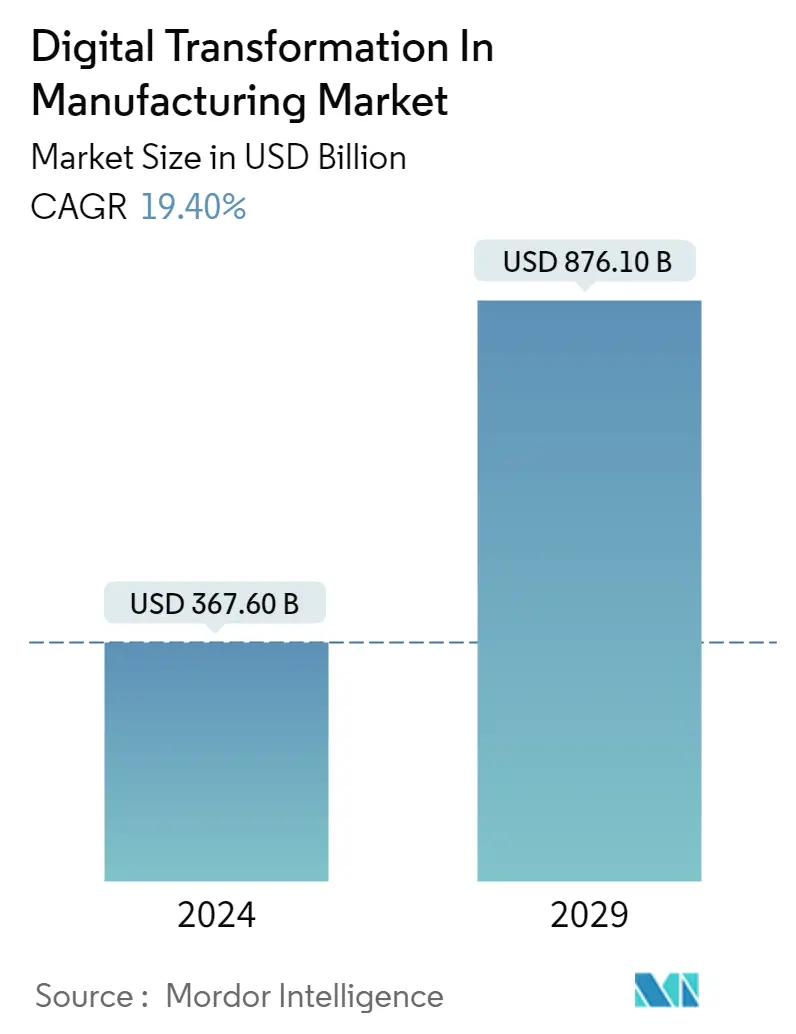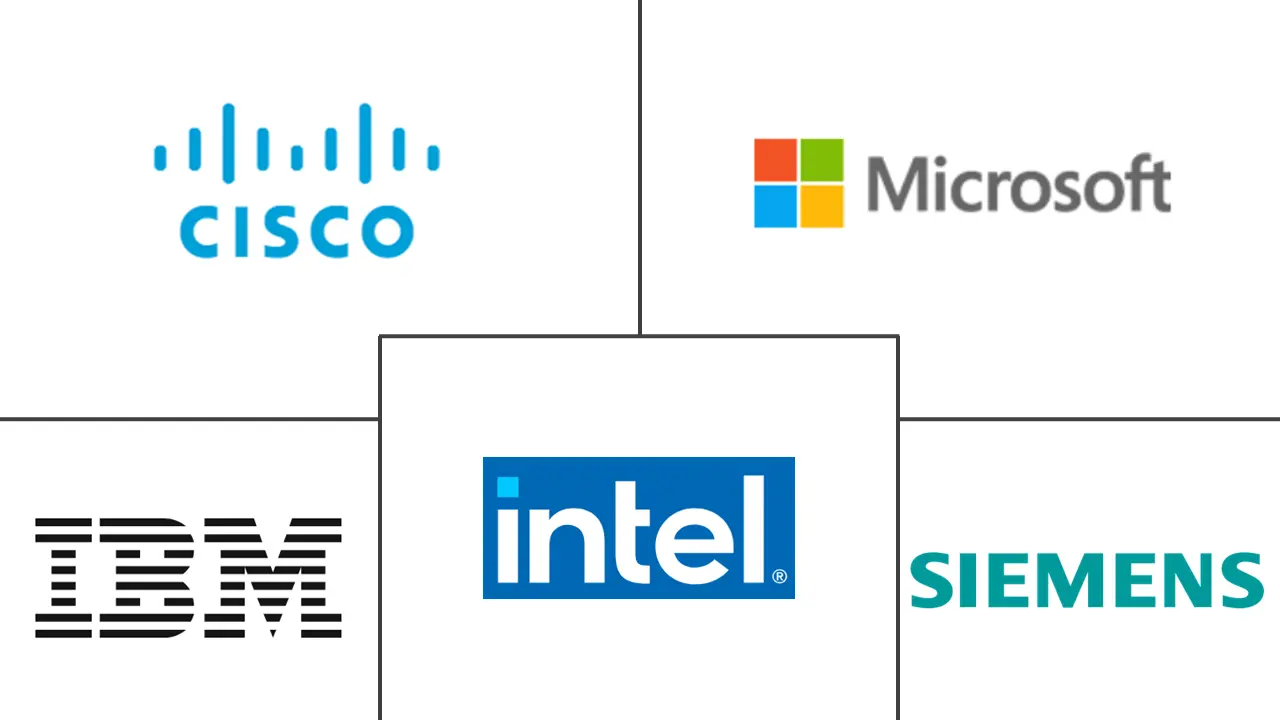Market Size of Digital Transformation In Manufacturing Industry

| Study Period | 2019 - 2029 |
| Market Size (2024) | USD 367.60 Billion |
| Market Size (2029) | USD 876.10 Billion |
| CAGR (2024 - 2029) | 19.40 % |
| Fastest Growing Market | Asia Pacific |
| Largest Market | Asia Pacific |
Major Players
*Disclaimer: Major Players sorted in no particular order |
Digital Transformation in Manufacturing Market Analysis
The Digital Transformation In Manufacturing Market size is estimated at USD 367.60 billion in 2024, and is expected to reach USD 876.10 billion by 2029, growing at a CAGR of 19.40% during the forecast period (2024-2029).
- The digitalization of the manufacturing sector impacts every aspect of operations and the supply chain. It begins with the design of the equipment and continues with the product design, production process development, and, finally, the monitoring and improvement of the end-user experience. Through cross-border collaboration, digital transformation is revolutionizing how manufacturers communicate and maintain product and engineering design specifications on the cloud.
- In addition, the widespread use of Internet of Things (IoT) devices is transforming industrial processes and increasing productivity. IoT devices enable real-time monitoring, gathering, and analyzing data on various industrial processes. It enables preventative maintenance, reduces energy use, and boosts overall productivity.
- With the help of these tools, stakeholders, systems, and machines can communicate and work together more easily, streamlining processes and decreasing downtime. By integrating IoT devices, manufacturers can improve quality control, manage inventories in real-time, and improve supply chain visibility.
- However, there are significant up-front expenses related to digital transformation. Implementing new technologies, including IoT gadgets and automation systems, frequently necessitates large expenditures in hardware, training, software, and infrastructure, which can be financially challenging for certain businesses, impeding market expansion.
- The COVID-19 outbreak expedited the manufacturing industry's digital transition. As supply chains and worker availability were disrupted, businesses sought technological solutions to reduce risks and improve operational effectiveness. Automation, remote monitoring, and data analytics were essential for streamlining manufacturing procedures, controlling inventory, and guaranteeing worker safety. Along with enhancing resilience and agility to facilitate real-time data analysis, remote collaboration, and predictive maintenance, manufacturers implemented cloud-based platforms, IoT gadgets, and artificial intelligence in the face of upcoming challenges. This rapid digitization also cleared the way for smarter, more integrated factories to boost efficiency and creativity in the post-pandemic period.
Digital Transformation in Manufacturing Industry Segmentation
The digital transformation market in manufacturing is defined based on the revenues generated from the technologies such as robotics, IoT, 3D printing and additive manufacturing, cybersecurity, and artificial intelligence, used globally. The analysis is based on the market insights captured through secondary research and the primaries. The market also covers the major factors impacting the market's growth in terms of drivers and restraints.
The Digital Transformation Market in Manufacturing is segmented by technology (robotics, Internet-of-Things, 3D printing & additive manufacturing, cybersecurity, and other technologies) and geography (North America (United States, Canada), Europe (Germany, United Kingdom, France, and the rest of Europe), Asia-Pacific (China, Japan, India, and the rest of Asia Pacific), Latin America, Middle East & Africa). The market sizes and forecasts are in value (USD) for all the segments.
| By Technology | |
| Robotics | |
| IoT | |
| 3D Printing and Additive Manufacturing | |
| Cybersecurity | |
| Other Technologies |
| By Geography | ||||||
| ||||||
| ||||||
| ||||||
| Latin America | ||||||
| Middle East and Africa |
Digital Transformation In Manufacturing Market Size Summary
The digital transformation in the manufacturing industry is a comprehensive shift that affects all facets of operations and supply chains, from equipment design to end-user experience enhancement. This transformation is significantly driven by the integration of Internet of Things (IoT) devices, which facilitate real-time monitoring and data analysis, thereby enhancing productivity and operational efficiency. The adoption of these technologies enables manufacturers to streamline processes, improve quality control, and enhance supply chain visibility. However, the initial investment required for implementing such technologies can be substantial, posing challenges for some businesses. The COVID-19 pandemic accelerated this digital shift as manufacturers sought technological solutions to navigate disruptions in supply chains and workforce availability, leading to increased reliance on automation, remote monitoring, and data analytics.
Globally, regions like Asia-Pacific are witnessing rapid adoption of robotics and automation technologies, with countries such as China and Japan leading the charge in integrating advanced technologies like IoT, AI, and digital twins into their manufacturing processes. These innovations are aimed at boosting productivity, reducing costs, and enhancing operational efficiency. Initiatives like India's "Make in India" and "Digital India" are further propelling the digital transformation in manufacturing by promoting infrastructure and technology investments. The competitive landscape is marked by significant players such as Cisco Systems Inc., Microsoft Corporation, and Siemens AG, who are continuously innovating and expanding their offerings to maintain market share. The market is poised for substantial growth as manufacturers leverage these digital tools to gain a competitive edge in an evolving industry.
Digital Transformation In Manufacturing Market Size - Table of Contents
-
1. MARKET INSIGHTS
-
1.1 Market Overview
-
1.2 Industry Attractiveness - Porter's Five Forces Analysis
-
1.2.1 Bargaining Power of Suppliers
-
1.2.2 Bargaining Power of Consumers
-
1.2.3 Threat of New Entrants
-
1.2.4 Threat of Substitutes
-
1.2.5 Intensity of Competitive Rivalry
-
-
1.3 Industry Value Chain Analysis
-
1.4 Technology Snapshot
-
-
2. MARKET SEGMENTATION
-
2.1 By Technology
-
2.1.1 Robotics
-
2.1.2 IoT
-
2.1.3 3D Printing and Additive Manufacturing
-
2.1.4 Cybersecurity
-
2.1.5 Other Technologies
-
-
2.2 By Geography
-
2.2.1 North America
-
2.2.1.1 United States
-
2.2.1.2 Canada
-
-
2.2.2 Europe
-
2.2.2.1 Germany
-
2.2.2.2 United kingdom
-
2.2.2.3 France
-
2.2.2.4 Rest of Europe
-
-
2.2.3 Asia-Pacific
-
2.2.3.1 China
-
2.2.3.2 Japan
-
2.2.3.3 India
-
2.2.3.4 Rest of Asia Pacific
-
-
2.2.4 Latin America
-
2.2.5 Middle East and Africa
-
-
Digital Transformation In Manufacturing Market Size FAQs
How big is the Digital Transformation Market in Manufacturing Industry?
The Digital Transformation Market in Manufacturing Industry size is expected to reach USD 367.60 billion in 2024 and grow at a CAGR of 19.40% to reach USD 876.10 billion by 2029.
What is the current Digital Transformation Market in Manufacturing Industry size?
In 2024, the Digital Transformation Market in Manufacturing Industry size is expected to reach USD 367.60 billion.

